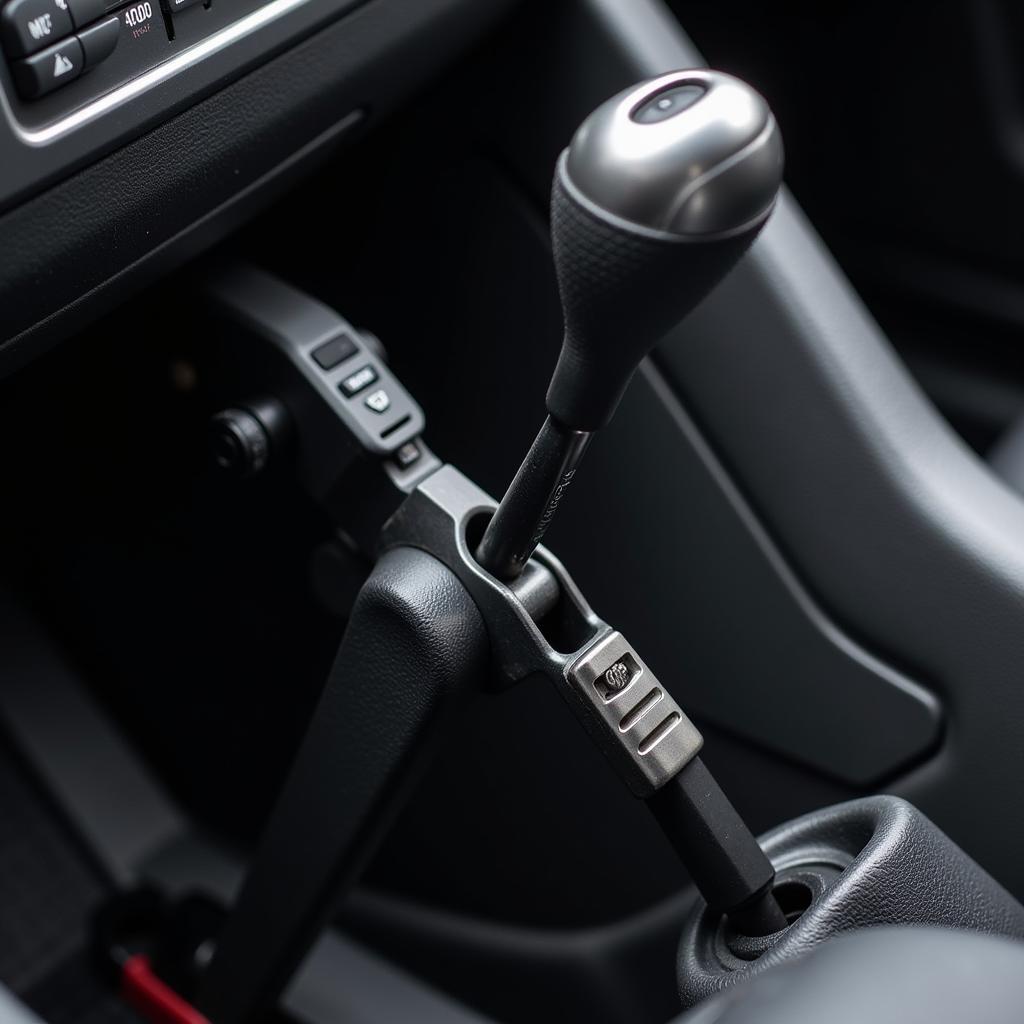A faulty handbrake can be a serious safety hazard. Knowing how to fix a handbrake on a car is essential for any car owner. This guide will walk you through common handbrake problems and provide step-by-step instructions for fixing them, whether it’s a simple adjustment or a more complex repair. Understanding your car’s handbrake system is the first step towards ensuring your safety and the proper functioning of your vehicle.
 Car Handbrake Engaged
Car Handbrake Engaged
Why is My Handbrake Not Working?
There are several reasons why your car’s handbrake might not be functioning correctly. These can range from simple adjustments to more complex mechanical issues. Some of the most common culprits include:
- Worn brake shoes or pads: Over time, the friction material on your handbrake shoes or pads wears down, reducing their effectiveness.
- Stretched handbrake cable: A stretched cable can prevent the handbrake from applying enough force to hold the car.
- Seized handbrake mechanism: Rust, corrosion, or lack of lubrication can cause the handbrake mechanism to seize.
- Parking brake lever issues: The lever itself could be damaged or malfunctioning.
How to Adjust a Car Handbrake
Often, a simple adjustment is all that’s needed to fix a poorly performing handbrake. Here’s a general guide. However, consult your car’s owner’s manual for specific instructions as procedures can vary between makes and models.
- Locate the adjusting nut: This is usually located under the center console or beneath the car near the handbrake lever.
- Loosen the nut: Turn the adjusting nut counterclockwise to tighten the handbrake cable.
- Test the handbrake: Apply the handbrake and ensure it engages securely after a few clicks (typically 3-5). The car should not roll on a slight incline.
- Fine-tune the adjustment: If the handbrake is too tight or too loose, continue adjusting the nut until you achieve the correct tension.
Having trouble with your clutch? Check out this helpful guide: how to fix a slipping clutch on a car.
How to Replace a Handbrake Cable
A stretched or broken handbrake cable requires replacement. This is a more complex job that might be best left to a professional, but if you’re mechanically inclined, here’s a general overview:
- Remove the old cable: Disconnect the cable from the handbrake lever and the brake mechanism at the rear wheels.
- Install the new cable: Route the new cable following the same path as the old one.
- Adjust the new cable: Follow the adjustment procedure described earlier.
Don’t let a flat tire ruin your day. Learn how to fix a hole in a car tyre for those emergency situations.
Troubleshooting Specific Handbrake Problems
What if my handbrake feels spongy?
A spongy handbrake often indicates air in the brake lines. This usually requires bleeding the brake system, which is best done by a professional.
How to fix a stuck handbrake?
A stuck handbrake could be due to a seized mechanism. Trying to force it could cause further damage. Applying penetrating oil to the affected areas can sometimes free it up. If not, professional assistance is recommended.
“Regular maintenance is key to preventing handbrake problems. Just like any other part of your car, the handbrake needs periodic checks and adjustments,” says Robert Miller, ASE Certified Master Technician.
How Much Does it Cost to Fix a Handbrake?
The cost to fix a car handbrake can vary depending on the issue. A simple adjustment might be relatively inexpensive, while replacing the entire handbrake assembly can be significantly more costly. Learn more about pricing here: how much does it cost to fix a car handbrake. Getting an accurate diagnosis from a qualified mechanic is essential.
“Don’t ignore a faulty handbrake. It’s a crucial safety feature and neglecting it could put you and others at risk,” advises Susan Davis, Automotive Safety Expert.
What if you need dealer fixing a car after an accident? Knowing your options is crucial.
Conclusion
Fixing a handbrake on a car can range from a simple adjustment to a more involved repair. Understanding the underlying causes and following the appropriate steps will help ensure your car’s safety and proper functioning. Regular maintenance and prompt attention to any issues are crucial for preventing more serious problems down the road. Remember, a properly functioning handbrake is vital for your safety and the safety of others. If you are not comfortable working on your car’s brakes, it’s always best to consult a qualified mechanic. Connect with us at AutoTipPro for further assistance. Our phone number is +1 (641) 206-8880, and our office is located at 500 N St Mary’s St, San Antonio, TX 78205, United States.
“Remember, a well-maintained handbrake provides peace of mind, knowing your vehicle is secured,” reminds us David Wilson, Lead Automotive Instructor.




Leave a Reply